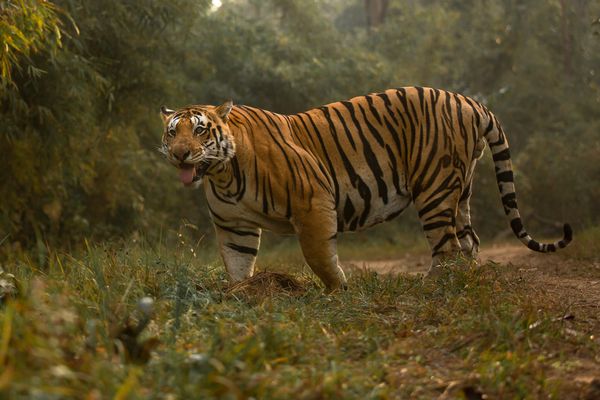Places to see in Kanha National Park
Kanha inspired Rudyard Kipling to write the Jungle Book. The landscape of Kanha is a beautiful mix of meadows, woodlands, bamboo thickets, and water bodies. This is one park which is very soothing to the eyes and the soul. Kanha also has the largest male Tigers in India, and sighting even one of them will leave an indelible mark on your memory. Apart from Tigers, this parks have Sloth Bears, Leopards, Indian Wild Dogs, variety of prey animals, and close to 300 species of birds.

The Kipling Country
In Madhya Pradesh, one can see the forests immortalised by Rudyard Kipling in his Jungle Book – the home of Balu, Forest Department guides accompany visitors around the park on mapped-out circuits which enable viewers to see a good cross-section of Kanha’s wildlife. The best areas are the meadows around Kanha, where blackbuck, chital and barasingha can be seen throughout the day.
Bamni Dadar
Known as Sunset Point, this is one of Hardground Barasingha is found only at Kanha The most beautiful areas of the park, from where a spectacular sunset can be watched. The dense luxuriance of Kanha’s forests can best be seen from here. Animals that can be sighted around this point are typical of the mixed forest zone: sambar, barking deer, gaur and the four-horned antelope.
Mammalian Species
Kanha has some 22 species of mammals. Those most easily spotted are the striped palm squirrel, common langur, jackal, wild pig, chital or spotted deer, barasingha or swamp deer, sambar and blackbuck.
Less commonly seen species
Tiger, Indian hare, dhole or Indian wild dog, barking deer and Indian bison or gaur. Patient watching should reward the visitor with a sight of: Indian fox, sloth bear, striped hyena, jungle cat, leopard, Mouse deer, chausingha or four-horned antelope, nilgai, ratel and porcupine.
Less commonly seen species
Tiger, Indian hare, dhole or Indian wild dog, barking deer and Indian bison or gaur. Patient watching should reward the visitor with a sight of: Indian fox, sloth bear, striped hyena, jungle cat, leopard, Mouse deer, chausingha or four-horned antelope, nilgai, ratel and porcupine.
Best Season
February to June, although the cool season is much more comfortable and still very good for wildlife. (The park is closed from July 1 to October 31 because of the monsoon). For those planning a visit, a stay of at least three nights is recommended in order to have a good chance of seeing the more elusive animals – although, of course, a brief visit will also be very interesting.
What to Wear
Cottons, but bring woollens as well, as early mornings and evenings can be chilly, especially in a moving jeep and in the cool season. Try not to wear loud colours.
Kisli or Mukk
There is NO FACILITY FOR ENCASHING TRAVELLER’S CHEQUESat Kisli or Mukki – the nearest bank dealing in foreign exchange is the State Bank at Mandla.
How to Reach
Khatia (3 km from Kisli) and Mukki are the two main entry points to the Kanha National Park. From Jabalpur, Kisli is 165 km via Chiraidongri, and Mukki is 203 km via Motinala and Garhi. For travellers from Bilaspur (182 km), Raipur (213 km) and Balaghat (83 km), Mukki on State Highway No. 26 is more convenient. From Nagpur, Kisli is 259 km via Nainpur and Chiraidongri, and Mukki is 289 km via Balaghat.
The Kanha Museum, located at park headquarters in Kanha Village, contains fascinating, well-conceived exhibits relating to the entire ecosystem and its fauna and flora. The museum complex consists of six rooms distributed between two buildings. The museum opens daily at 7 A.M. and remains accessible to visitors during park excursion hours throughout the day. Below is a summary of the exhibits.
Very rarely seen are
Wolf, which lives in the far east of the park; chinkara, to be found outside the park’s northern boundary; Indian pangolin, the smooth Indian otter and the small Indian civet.
Avian Species: Kanha has some 200 species of birds. Watchers should station themselves in the hills, where the mixed and bamboo forests harbour many species, and in the grassy forest clearings., Water birds can be seen near the park’s many rivulets and at Sarvantal, a pool that is frequented by water birds and the area in front of the museum.
The sal forests do not normally yield a sight of Kanha’s avifauna. Early mornings and late afternoons are best for birdwatching; binoculars are an invaluable aid to the watcher.
Commonly seen species include: cattle egret, pond heron, black ibis, common peafowl, crested serpent, rackettailed drongo, hawk eagle and red-wattled lapwing; various species of flycatcher, woodpecker, pigeon, dove, parakeet, babbler and mynah; Indian roller, white-breasted kingfisher and grey hornbill. Jeep and Elephant Hire.
MPSTDC jeeps are available on hire for touring the park. Elephants are used for tiger-tracking and should a tiger be located, the elephant can take visitors to the site. For jeep hire, see the MPSTDC Manager, at the Baghira Log Huts, Kisli and Kanha Safari Lodge, Mukki. Bookings for a morning run should be made the previous day., Please bear in mind that jeeps are not always available during peak visiting periods.






